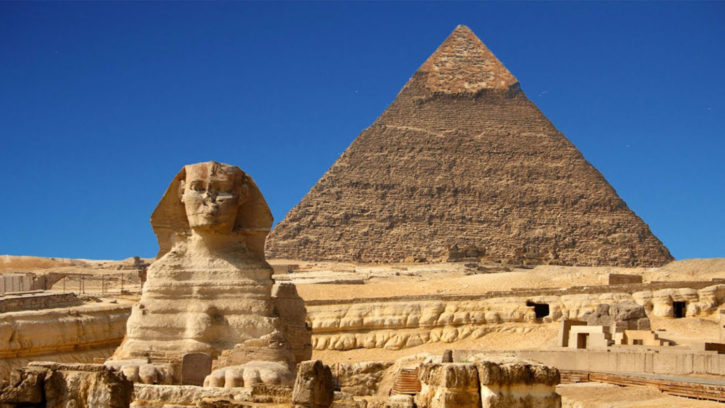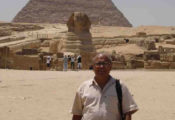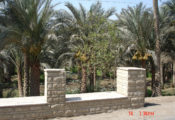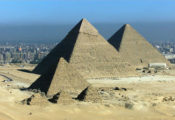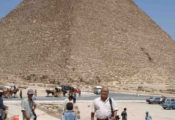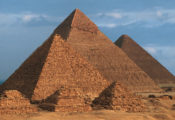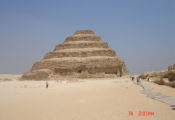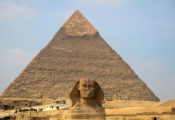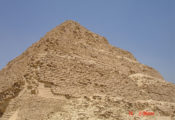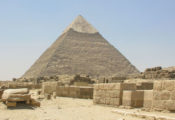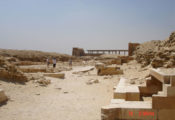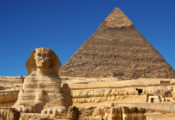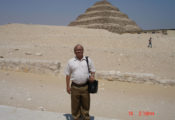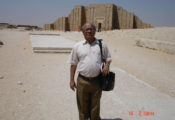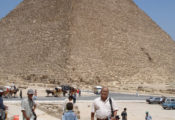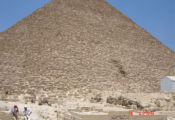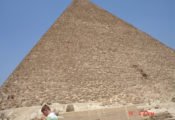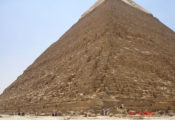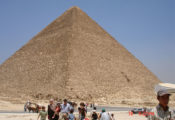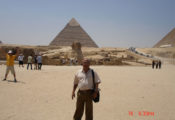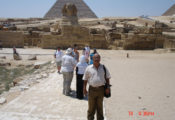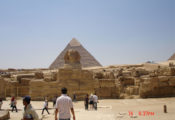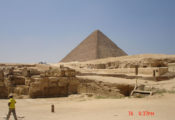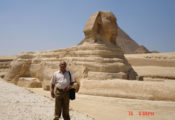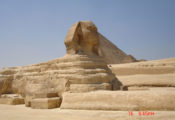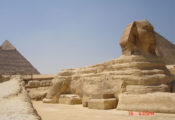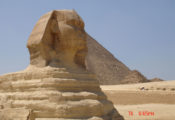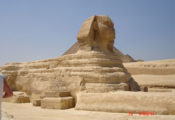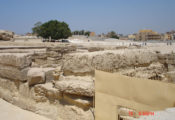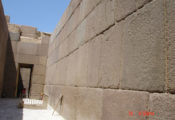14/8/2007
When we think about Egypt, first we look for the Pyramids of Giza.
Egyptian civilization has flourished continuously since pre-historic times. Egypt was one of the richest and most powerful civilizations in the world, the pyramids—especially the Great Pyramids of Giza—are some of the most magnificent man-made structures in history. At one place there is a sphinx, a mythical creature with the body of a lion and the head of a human. Their massive scale reflects the unique role that the pharaoh, or king, played in ancient Egyptian society. The first, and largest, pyramid at Giza was built by the Pharaoh Khufu (reign started around 2551 B.C.). His pyramid, which today stands 455 feet (138 meters) tall, is known as the “Great Pyramid” and was considered to be a wonder of the world by ancient writers.
The pyramid of Khafre (reign started around 2520 B.C.) was only slightly smaller than Khufu’s but stood on higher ground. Many scholars believe that the Sphinx monument, which lies near Khafre’s pyramid, was built by Khafre, and that the face of the Sphinx was modeled after him. The third pharaoh to build a pyramid at Giza was Menkaure (reign started around 2490 B.C.), who opted for a smaller pyramid that stood 215 feet (65 m) high.
In 332 B.C. Alexander the Great drove the Persians out of Egypt and incorporated the country into the Macedonian Empire. After Alexander the Great’s death, a line of rulers descended from Ptolemy Soter, one of Alexander’s generals. The last of these “Ptolemaic” rulers (as scholars often call them) was Cleopatra VII, who committed suicide in 30 B.C after the defeat of her forces by the Roman emperor Augustus at the Battle of Actum . After her death, Egypt was incorporated into the Roman Empire. Although the Roman emperors were based in Rome, the Egyptians treated them as pharaohs. One recently excavated carving shows the emperor Claudius (reign A.D. 41-54) dressed as a pharaoh. The carving has hieroglyphic inscriptions that say that Claudius is the “Son of Ra, Lord of the Crowns,” and is “King of Upper and Lower Egypt, Lord of the Two Lands.”
Centuries later, Cairo developed as Al-Fusṭaṭ, capital of the Muslim province of Egypt by the Fatimids. The Fatimid Caliphate was an Ismaili Shia caliphate that spanned a large area of North Africa, from the Red Sea in the east to the Atlantic Ocean in the west. The dynasty of Arab origin ruled across the Mediterranean coast of Africa and ultimately made Egypt the center of the caliphate in the 10th century. The 12th Century brought Saladin, the first Sultan of Egypt, who commissioned many more important buildings. Then in the mid-13th century, the Mamaluks seized control of Egypt. Under them, Cairo became an important centre of Islamic learning. The rising Ottomans took over from the Mamaluks in the 16th century and with the rise of Constantinople as their capital, cairo declained. The Black Death struck the city countless times, reducing the population by hundreds of thousands. After resisting Napoleonic rule, Muhammad Ali Pasha founded the modern Egyptian state in the early 19th century with social and economic reforms and huge construction ensuing Broad boulevards and circular plazas inspired by Paris can still be seen around todays Downtown Cairo.
The British used Egyptian debt as a pretex for occupying the country from 1882. Huge prot4ests led to the declaration of independence in 1922 but colonial dominance continued until the Egyptian revolution of 1952. Under the iconic Nassar, Cairo developed into a modern metropolis with Egyptians from all over the country pouring in, it eventually became a largest city in the Islamic world, and one of the biggest in Africa.
Located on the banks of the Nile River, Cairo, Egypt’s capital, holds the special distinction of being home to the only one of the Seven Wonders of the Ancient World still standing: the Great Pyramid, completed around 2540 B.C. Not quite as old, the nearby Citadel was built on a hill by the caliph who defeated the invading Crusaders in the 12th century. The Citadel is famous for its views over Cairo, as well as for being the site of the grand Mohammed Ali Mosque. Built in the 1800s, the mosque is one of the first buildings visible when approaching the city. With its Ottoman-influenced architecture, the mosque resembles the Blue Mosque of Istanbul, another monument of Islam.
The history of Christianity in Egypt dates to just a few decades after Jesus died. During the Roman era, St. Mark is believed by scholars to have come to Alexandria to spread the gospel through Egypt. Cairo’s oldest area is the Coptic Christian area, which has five churches, the first mosque built in Egypt, the oldest synagogue in the country, and the ruins of Roman fortifications. Built on an old Roman fortress, the Hanging Church (so named because the nave was built between the ruins of two towers) has 110 religious icons; the oldest dating back to the eighth century.

